In a single-mode optical fiber, the zero-dispersion wavelength is the wavelength or wavelengths at which material dispersion and waveguide dispersion cancel one another. In all silica-based optical fibers, minimum material dispersion occurs naturally at a wavelength of approximately 1300 nm. Single-mode fibers may be made of silica-based glasses containing dopants that shift the material-dispersion wavelength, and thus, the zero-dispersion wavelength, toward the minimum-loss window at approximately 1550 nm. The engineering tradeoff is a slight increase in the minimum attenuation coefficient. Such fiber is called dispersion-shifted fiber.

A photonic crystal is an optical nanostructure in which the refractive index changes periodically. This affects the propagation of light in the same way that the structure of natural crystals gives rise to X-ray diffraction and that the atomic lattices of semiconductors affect their conductivity of electrons. Photonic crystals occur in nature in the form of structural coloration and animal reflectors, and, as artificially produced, promise to be useful in a range of applications.
In optics, an ARROW is a type of waveguide that uses the principle of thin-film interference to guide light with low loss. It is formed from an anti-resonant Fabry–Pérot reflector. The optical mode is leaky, but relatively low-loss propagation can be achieved by making the Fabry–Pérot reflector of sufficiently high quality or small size.
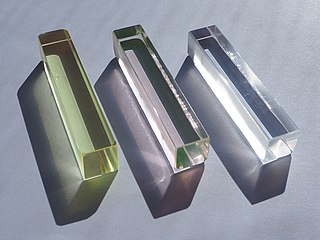
ZBLAN is the most stable, and consequently the most used, fluoride glass, a subcategory of the heavy metal fluoride glass (HMFG) group. Typically its composition is 53% ZrF4, 20% BaF2, 4% LaF3, 3% AlF3 and 20% NaF. ZBLAN is not a single material but rather has a spectrum of compositions, many of which are still untried. The biggest library in the world of ZBLAN glass compositions is currently owned by Le Verre Fluore, the oldest company working on HMFG technology. Other current ZBLAN fiber manufacturers are Thorlabs and KDD Fiberlabs. Hafnium fluoride is chemically similar to zirconium fluoride, and is sometimes used in place of it.
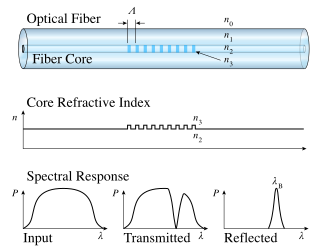
A fiber Bragg grating (FBG) is a type of distributed Bragg reflector constructed in a short segment of optical fiber that reflects particular wavelengths of light and transmits all others. This is achieved by creating a periodic variation in the refractive index of the fiber core, which generates a wavelength-specific dielectric mirror. Hence a fiber Bragg grating can be used as an inline optical filter to block certain wavelengths, can be used for sensing applications, or it can be used as wavelength-specific reflector.

A distributed Bragg reflector (DBR) is a reflector used in waveguides, such as optical fibers. It is a structure formed from multiple layers of alternating materials with different refractive index, or by periodic variation of some characteristic of a dielectric waveguide, resulting in periodic variation in the effective refractive index in the guide. Each layer boundary causes a partial reflection and refraction of an optical wave. For waves whose vacuum wavelength is close to four times the optical thickness of the layers, the interaction between these beams generates constructive interference, and the layers act as a high-quality reflector. The range of wavelengths that are reflected is called the photonic stopband. Within this range of wavelengths, light is "forbidden" to propagate in the structure.

Plastic optical fiber (POF) or polymer optical fiber is an optical fiber that is made out of polymer. Similar to glass optical fiber, POF transmits light through the core of the fiber. Its chief advantage over the glass product, other aspect being equal, is its robustness under bending and stretching.

An optical fiber, or optical fibre, is a flexible glass or plastic fiber that can transmit light from one end to the other. Such fibers find wide usage in fiber-optic communications, where they permit transmission over longer distances and at higher bandwidths than electrical cables. Fibers are used instead of metal wires because signals travel along them with less loss and are immune to electromagnetic interference. Fibers are also used for illumination and imaging, and are often wrapped in bundles so they may be used to carry light into, or images out of confined spaces, as in the case of a fiberscope. Specially designed fibers are also used for a variety of other applications, such as fiber optic sensors and fiber lasers.
An optical waveguide is a physical structure that guides electromagnetic waves in the optical spectrum. Common types of optical waveguides include optical fiber waveguides, transparent dielectric waveguides made of plastic and glass, liquid light guides, and liquid waveguides.
Philip St. John Russell, FRS, is Emeritus Director of the Max Planck Institute for the Science of Light in Erlangen, Germany. His area of research covers "photonics and new materials", in particular the examination of new optical materials, especially of photonic crystal fibres, and more generally the field of nano- and micro-structured photonic materials.

In optics, a supercontinuum is formed when a collection of nonlinear processes act together upon a pump beam in order to cause severe spectral broadening of the original pump beam, for example using a microstructured optical fiber. The result is a smooth spectral continuum. There is no consensus on how much broadening constitutes a supercontinuum; however researchers have published work claiming as little as 60 nm of broadening as a supercontinuum. There is also no agreement on the spectral flatness required to define the bandwidth of the source, with authors using anything from 5 dB to 40 dB or more. In addition the term supercontinuum itself did not gain widespread acceptance until this century, with many authors using alternative phrases to describe their continua during the 1970s, 1980s and 1990s.
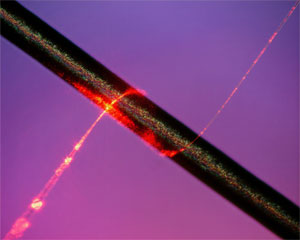
A subwavelength-diameter optical fibre is an optical fibre whose diameter is less than the wavelength of the light being propagated through it. An SDF usually consists of long thick parts at both ends, transition regions (tapers) where the fibre diameter gradually decreases down to the subwavelength value, and a subwavelength-diameter waist, which is the main acting part. Due to such a strong geometrical confinement, the guided electromagnetic field in an SDF is restricted to a single mode called fundamental. In usual optical fibres, light both excites and feels shear and longitudinal bulk elastic waves, giving rise to forward-guided acoustic wave Brillouin scattering and backward-stimulated Brillouin scattering. In a subwavelength-diameter optical fibre, the situation changes dramatically.
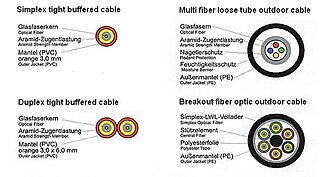
Hard-clad silica (HCS) or polymer-clad fiber (PCF) is an optical fiber with a core of silica glass and an optical cladding made of special plastic. In contrast to all-silica fiber, the core and cladding can be separated from each other.
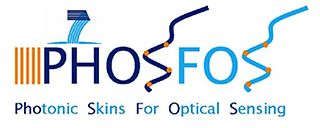
PHOSFOS is a research and technology development project co-funded by the European Commission.
Cladding in optical fibers is one or more layers of materials of lower refractive index in intimate contact with a core material of higher refractive index.
Optofluidics is a research and technology area that combines the advantages of fluidics and optics. Applications of the technology include displays, biosensors, lab-on-chip devices, lenses, and molecular imaging tools and energy.

Structural coloration in animals, and a few plants, is the production of colour by microscopically structured surfaces fine enough to interfere with visible light instead of pigments, although some structural coloration occurs in combination with pigments. For example, peacock tail feathers are pigmented brown, but their microscopic structure makes them also reflect blue, turquoise, and green light, and they are often iridescent.
Microstructured optical fibers (MOF) are optical fiber waveguides where guiding is obtained through manipulation of waveguide structure rather than its index of refraction.
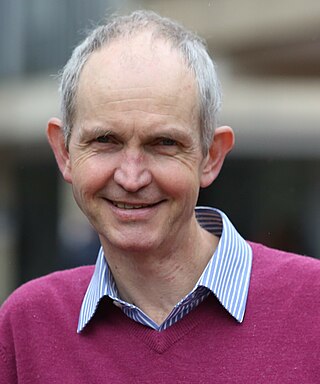
Jonathan C. Knight, is a British physicist. He is the Pro Vice-Chancellor (Research) for the University of Bath where he has been Professor in the Department of Physics since 2000, and served as head of department. From 2005 to 2008, he was founding Director of the university's Centre for Photonics and Photonic Materials.
Photonic crystal sensors use photonic crystals: nanostructures composed of periodic arrangements of dielectric materials that interact with light depending on their particular structure, reflecting lights of specific wavelengths at specific angles. Any change in the periodicity or refractive index of the structure can give rise to a change in the reflected color, or the color perceived by the observer or a spectrometer. That simple principle makes them useful colorimetric intuitive sensors for different applications including, but not limited to, environmental analysis, temperature sensing, magnetic sensing, biosensing, diagnostics, food quality control, security, and mechanical sensing. Many animals in nature such as fish or beetles employ responsive photonic crystals for camouflage, signaling or to bait their prey. The variety of materials utilizable in such structures ranging from inorganic, organic as well as plasmonic metal nanoparticles makes these structures highly customizable and versatile. In the case of inorganic materials, variation of the refractive index is the most commonly exploited effect in sensing, while periodicity change is more commonly exhibited in polymer-based sensors. Besides their small size, current developments in manufacturing technologies have made them easy and cheap to fabricate on a larger scale, making them mass-producible and practical.














